Turkey
Meleagris
A turkey's gender can be determined by the shape of its droppings.
Advertisement
Turkey Scientific Classification
- Kingdom
- Animalia
- Phylum
- Chordata
- Class
- Aves
- Order
- Galliformes
- Family
- Phasianidae
- Genus
- Meleagris
- Scientific Name
- Meleagris
Read our Complete Guide to Classification of Animals.
Turkey Conservation Status
Turkey Facts
- Lifestyle
- Flock
- Favorite Food
- Insects
- Type
- Bird
- Slogan
- Closely related to pheasants and chickens!
- Nesting Location
- Wooded areas on the ground
- Age of Molting
- 20 weeks
View all of the Turkey images!
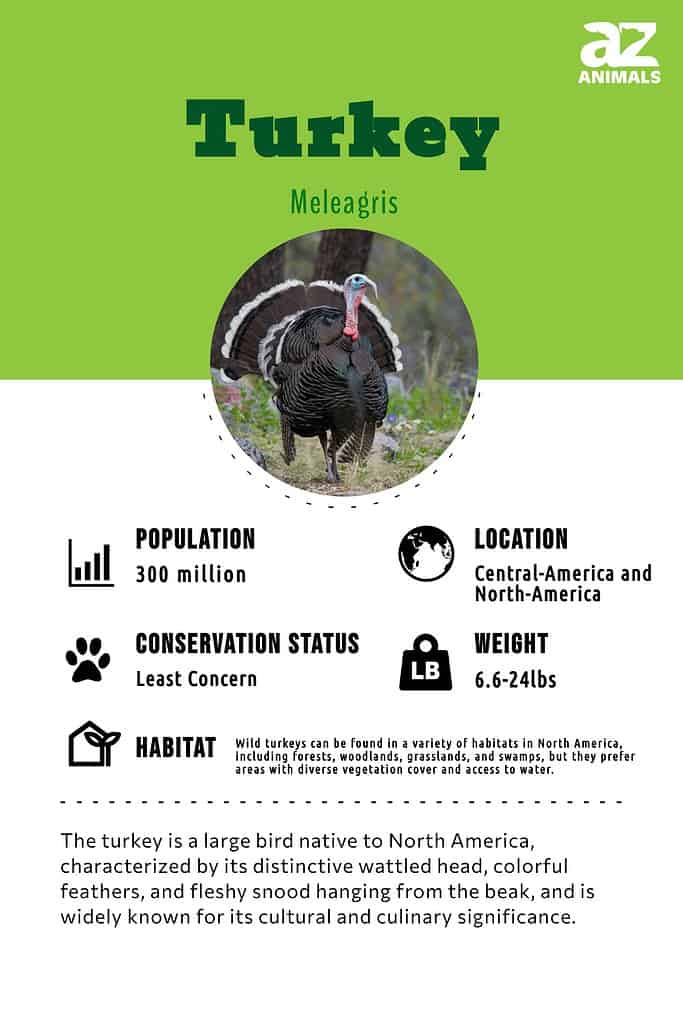
The turkey is a fascinating bird that is directly related to dinosaurs like the velociraptor. It’s an intelligent and social animal, and it’s also related to pheasants and grouse. These birds can be found all across the United States, Canada, and Mexico.
An Amazing Bird: 3 Turkey Facts
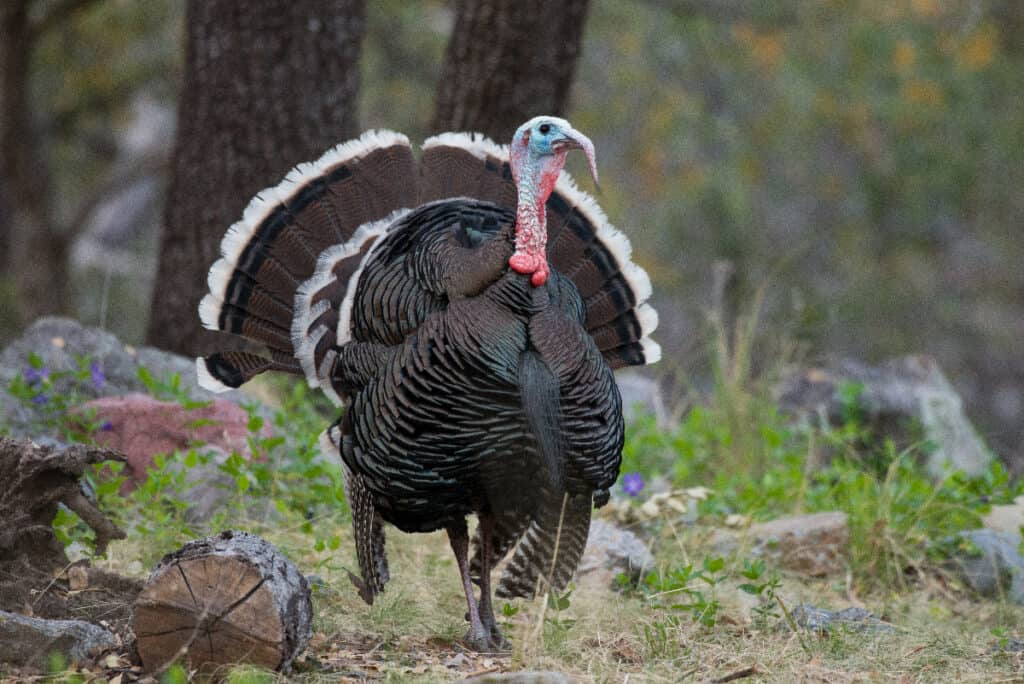
When awake, turkeys spend most of their time looking for food.
©Sean R. Stubben/Shutterstock.com
- A turkey’s gender can be determined by droppings. Male droppings form a “J” shape; female droppings are spiral.
- Only males gobble.
- Benjamin Franklin wanted the wild turkey to be the United States national bird.
Where to Find These Birds
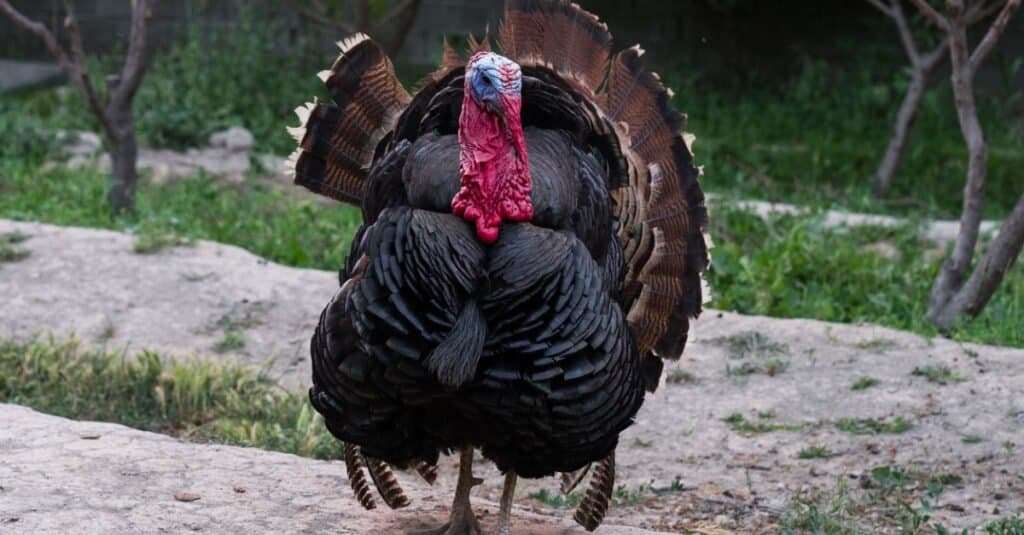
Turkeys love to be stroked, petted, and cuddled. They will remember your face and if they like you, they will come up to you to greet you.
©iStock.com/DA69
There are two primary species. The one that most people are familiar with is the wild turkey, the same species as the turkeys that are raised for the table, but domesticated turkeys tend to be heavier birds since they are bred to be eaten. This species is native to North America, and it can be found in almost every part of the United States. Some are even found in the northern regions of Mexico.
These birds aren’t especially popular among birdwatchers, but they are sought after by hunters. Hunting seasons vary by state, but most take place in late spring.
The second species is known as the ocellated turkey, and it is native to the Yucatan Peninsula of Mexico. At one point, researchers classified these birds separately from the North American species, but they are extremely similar, so they have since been placed into the same genus.
Ocellated turkeys are more endangered, so Mexican authorities are stricter about hunting. They typically employ “hunting tourism” trips in the spring in order to manage the bird population safely.
Evolution and Origins
The domesticated turkeys that we have today were originally descended from the tamed Aztec birds found in southern Mexico, with the sixth “South Mexican” subspecies serving as the wild progenitor, while domestic turkeys bred by the Anasazi in the Four Corners region were linked to the Eastern and Rio Grande subspecies.
Turkeys have been evolving in North America for more than 20 million years and share a recent common ancestor with other fowl like grouse and pheasants, and it is the wild turkey species that was the forefather of the domesticated turkey that was tamed around 2,000 years ago.
The domesticated turkeys commonly found on farms were derived from the Wild Turkey species, which is originally from the eastern and southwestern parts of the United States and Mexico, and it is believed that the Mayans, who lived in southern Mexico, were the pioneers of turkey domestication, about 2000 years ago.
Different Types of Turkeys
There are currently two turkey species that are still in existence: the wild turkey, which is found in the eastern and central parts of North America, and the ocellated turkey, which is found in the Yucatan Peninsula in Mexico.
Bird Nests
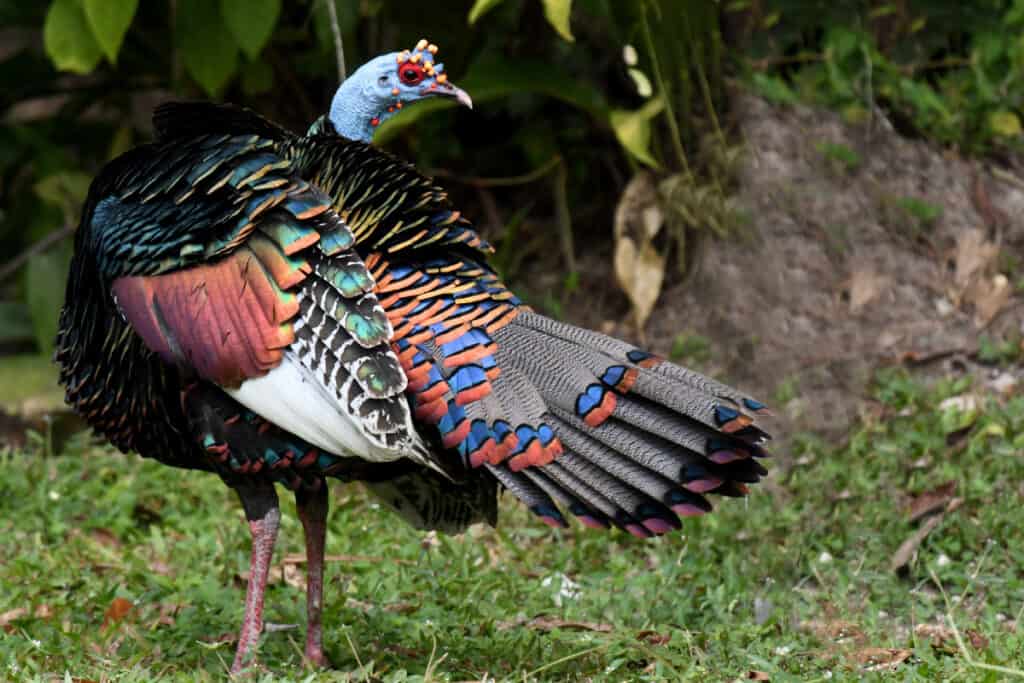
©Lev Frid/Shutterstock.com
These large birds create their nests on the ground, typically at the base of a tree. The female will scratch a shallow rut into the soil near the tree’s roots and use the dead leaves and plant material that has accumulated in the spot as nesting material.
Scientific Name
The wild turkey’s scientific name is Meleagris gallopavo. The origin of this name is a bit unusual. The word “Meleagris” comes from a Greek myth in which Artemis, the goddess of the hunt, turns the sisters of the slain hero Meleager into guinea fowl. Its second name, “gallopavo,” is derived from two Latin words: “gallus,” which means rooster, and “pavo,” which means peacock.
The ocellated turkey’s scientific name is Meleagris ocellata. The word “ocellata” is derived from the Latin “ocellatus,” or “little eye.” The name refers to the eyelike spots that appear on the tail feathers of these birds.
Size, Appearance, and Behavior
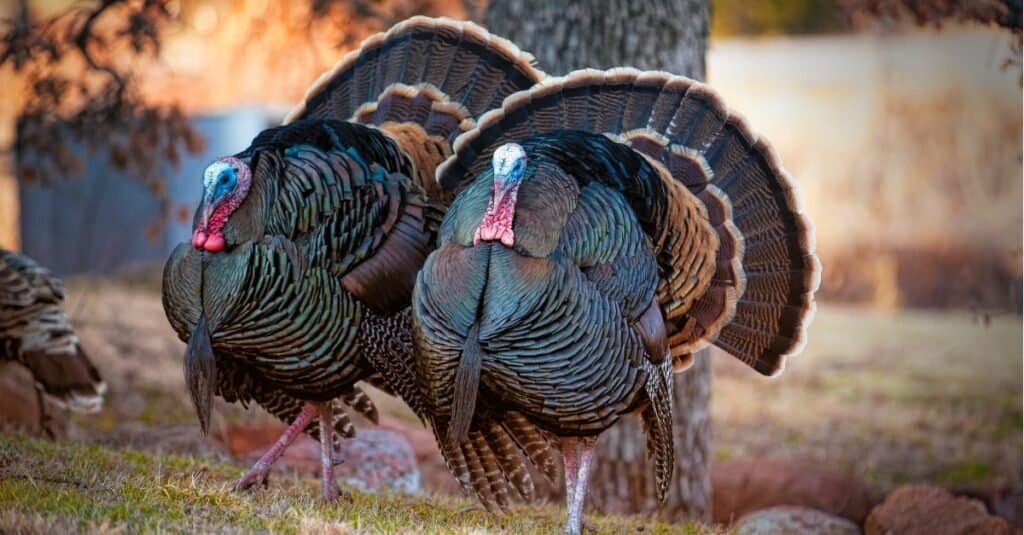
There are two families of turkeys: Phasianidae and Meleagrididae.
©iStock.com/davidsdodd
Wild male turkeys, known as “toms,” typically weigh 11 to 23 pounds and measure about 45 inches in length. According to the National Wild Turkey Federation, the largest wild tom on record weighed 37.1 pounds. In contrast, domesticated turkeys’ average weight is 30 to 80 pounds, and the largest bird on record weighed 86 pounds. They also grow to be about 45 inches long.
Females are called “hens,” and they are smaller and lighter than toms. Wild hens are only about 11 pounds in weight, and they usually measure about 35 inches long. Domesticated hens may be up to 18 pounds in weight. Both males and females have a wingspan of about 48 to 57 inches.
Adult wild males, or “toms,” have large bodies covered in gray-brown feathers that sport a coppery sheen. Their heads are featherless and red with bright red throats and red wattles on the throat and neck as well. They have long, glossy, and colorful tail feathers that create the distinctive fan shape that turkeys are often known for. Juvenile males are called “jakes,” and they can be identified by their short beards and the presence of longer feathers in the middle of their tails. Toms have tail feathers of uniform size and length.
Adult females, or “hens,” have feathers that are dull gray or brown, and they do not have colorful tail feathers like males. They are able to fan their tail feathers like males, but they seldom do so. Juvenile females are called “jennies,” and they look nearly identical to hens aside from their smaller size.
Both sexes have a fleshy protuberance called a snood that hangs over the beak, and both can also have a small tuft of feathers under the beak called a beard. Males will also have short, sharp spurs protruding from their legs near the feet.
For ocellated turkeys, both males and females sport iridescent bronze and green feathers. They both have shorter fan tails that are blue-gray in color with a small, eye-shaped spot at the tip. This is where the name “ocellated” comes from. Like North American turkeys, they also have black and white striped wing feathers.
Ocellated turkeys are even smaller birds than wild turkeys. Toms weigh up to 13 pounds at their heaviest, and hens weigh 6 to 8 pounds. Both sexes average 24 to 36 inches in length and have a wingspan range of 26 to 30 inches.
Both sexes also have bright blue heads with orange snoods and dark red legs. Males have sharp spurs on their legs, but they are longer and thinner than their North American counterparts.
A group of domesticated turkeys is called a rafter. Check out this article to learn why. Plus, discover how these birds function in groups.

©veleknez/Shutterstock.com
Diet: An Omnivorous Bird
These birds are omnivores, which means that they eat plants as well as meat. They typically survive on a diet of foraged fruit, veggies, grasses, insects, and acorns. Because they are so large, they require a lot of protein in order to stay healthy. In the winter, acorns are a staple of a nutritious diet.
What do turkeys eat?
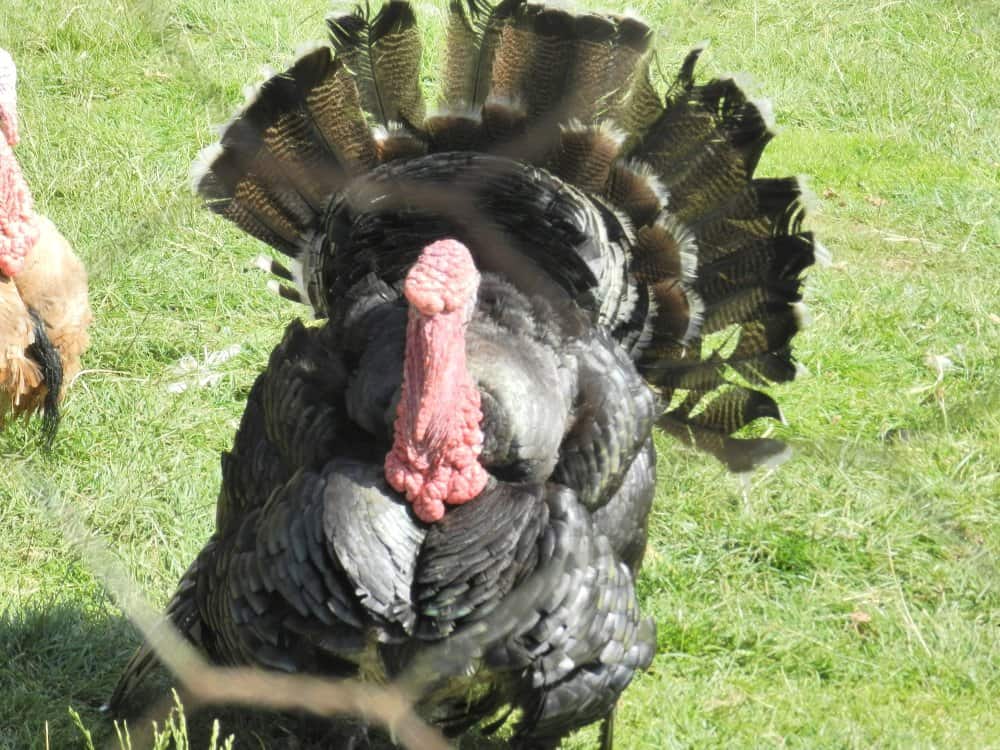
Turkey at Jimmys Farm
©Millie Bond – Copyright A-Z Animals
Both ocellated and North American turkeys have similar preferences when it comes to food. In the wild, they feed on insects, nuts, leaves, fruit, and grass. Domesticated turkeys are generally fed a broad variety of garden scraps alongside high-protein turkey feed. For a complete list of foods turkeys eat, check out our “What Do Turkeys Eat?” page.
Predators, Threats & Conservation Status
These birds have a rather long list of predators, which explains why they can be so aggressive in the wild. The North American turkey is not endangered, and its primary predator is human hunters. They are popular game birds across the United States.
Ocellated turkeys are marked as “near threatened” due to a combination of habitat loss and hunting. The population has rebounded in recent years, but they are still carefully monitored.
What animals eat turkeys?
Many animals besides humans eat these birds. Other predators include domestic dogs, coyotes, weasels, foxes, bobcats, skunks, opossums, raccoons, hawks, and owls.
Reproduction, Babies & Lifespan
Wild turkey mating happens in the spring. Males will perform a “courtship dance” that involves puffing out their feathers, fanning their impressive tails, and gobbling loudly while dancing around in the presence of females. These birds can mate with multiple partners and do not pair up.
Once the female is inseminated, she will find a nesting spot and lay one egg each day, up to 17 eggs. An average clutch is typically 7 to 10 eggs. Eggs take about 28 days to hatch.
Babies are called chicks or poults, and they stay in the nest with their mother for 2 weeks after hatching. After this time, they learn to roost in trees alongside their mother. These birds are extremely social, so they stay together in groups to play and learn survival skills, and poults will continue to stay with their mothers until the next breeding season arrives.
In the wild, these creatures usually live for 3 to 5 years. Domesticated turkeys may live up to 10 years. However, turkeys raised for slaughter typically only live for about 18 weeks.
Population
According to the National Wild Turkey Foundation, there are roughly 6.2 million North American turkeys in the wild.
It’s difficult to obtain reliable data on ocellated turkey population numbers, but researchers estimate that 20,000 to 50,000 birds currently live in the wild.
View all 133 animals that start with TTurkey FAQs (Frequently Asked Questions)
Are Turkeys herbivores, carnivores, or omnivores?
Turkeys are Omnivores, meaning they eat both plants and other animals.
What Kingdom do Turkeys belong to?
Turkeys belong to the Kingdom Animalia.
What class do Turkeys belong to?
Turkeys belong to the class Aves.
What phylum to Turkeys belong to?
Turkeys belong to the phylum Chordata.
Do turkeys migrate?
Turkeys do not migrate. They live in the same habitats year-round.
How many eggs does a turkey lay?
An adult hen can lay up to 17 eggs in a single clutch.
How fast can turkeys fly?
Turkeys can only fly short distances, but they can fly up to 50 miles per hour.
What is a turkey's wingspan?
The average wingspan of an adult turkey ranges from 4.1 to 4.7 feet.
When do turkeys leave the nest?
Baby turkeys, called poults, typically stay close to their mothers for roughly half a year, first in the nest and then later when they learn to roost in trees.
What birds are turkeys related to?
Turkeys are closely related to pheasants, partridges and grouse.
Are turkeys dangerous?
In general, domestic turkeys aren’t a dangerous animal. They can become aggressive toward humans during mating season or if they feel threatened, so it’s best not to approach ones in the wild.
How long do turkeys live?
Wild turkeys can live up to 5 years, and domestic turkeys can live up to 10 years.
Can turkeys fly?
Despite their size, wild turkeys are able to fly short distances. They can also run and swim.
What family do Turkeys belong to?
Turkeys belong to the family Phasianidae.
What order do Turkeys belong to?
Turkeys belong to the order Galliformes.
What genus do Turkeys belong to?
Turkeys belong to the genus Meleagris.
What type of covering do Turkeys have?
Turkeys are covered in Feathers.
In what type of habitat do Turkeys live?
Turkeys live in forests, shrublands, and grassy plains.
What is the main prey for Turkeys?
Turkeys eat insects, nuts, seeds, and berries.
What are some predators of Turkeys?
Predators of Turkeys include foxes, snakes, and raccoons.
What is an interesting fact about Turkeys?
Turkeys are closely related to pheasants and chickens!
What is the scientific name for the Turkey?
The scientific name for the Turkey is Meleagris.
What are the differences between turkey and guinea fowl?
The biggest differences between a guinea fowl and a turkey include their size and egg size.
The average guinea fowl weighs up to 3.5 pounds, stand 1.9 feet tall, and grows 30 inches long with eggs that are about 2 inches in length, with a production rate between 80 and 160 eggs a year at the utmost. Turkeys weigh up to 30 pounds, measure 3.5 feet tall, and measure up to 46 inches in length while having eggs over 3.5 inches long while producing about 100 each year.
Thank you for reading! Have some feedback for us? Contact the AZ Animals editorial team.
Sources
- Wikipedia, Available here: https://en.wikipedia.org/wiki/Wild_turkey
- Wikipedia, Available here: https://en.wikipedia.org/wiki/Ocellated_turkey
- National Wild Turkey Federation, Available here: https://www.nwtf.org/
- All About Birds, Available here: https://www.allaboutbirds.org/guide/Wild_Turkey/
- The Atlantic, Available here: https://www.theatlantic.com/international/archive/2014/11/why-americans-call-turkey-turkey/
- Merriam-Webster, Available here: https://www.merriam-webster.com/dictionary/ocellated
- Sciencing, Available here: https://sciencing.com/a-turkey-reproduce-4709177.html

















